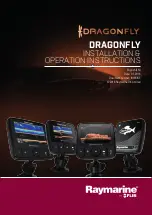
NOTE:
Due to the wide variety of boat hulls, it is not always possible to obtain high speed
depth readings.
NOTE:
It is often necessary to make several incremental transducer adjustments before
optimum high speed performance is achieved.
Once you have reached a consistently good sonar signal at the desired speeds, you are
ready to lock down the transducer settings.
5. Mark the transducer bracket location on the transom with a pencil, then pop up
the bracket to reveal the mounting screws. Tighten the stainless steel mounting
bracket screws to secure in place.
Hand-tighten only!
GPS RECEIVER INSTALLATION
To optimize performance of the GPS receiver, mount it in an area that has full exposure
to the sky. The effective area of reception is 10° above the horizon. Different
circumstances determine the mounting method appropriate for your GPS receiver.
If you have… Then use:
STEM MOUNTING WITH AN EXISTING 1" - 14 THREAD STEM
Follow these steps to stem mount the GPS receiver:
NOTE:
If you have an existing stem for mounting the GPS receiver, proceed directly to step 2
of the following procedure.
1. Determine the best location to mount your GPS receiver. Preplan and test the
cable routing to your control head before any drilling or cutting of your boat
surfaces. If you have purchased hardware to stem mount your GPS receiver,
follow the instructions included with that hardware to mount the stem
(antenna pole).
NOTE:
AS-EC10 10' extension cables are available from Humminbird® if your planned routing
exceeds 20', (6 m). Maximum cable length, including extensions, should not exceed 50' (16 m).
NOTE:
Remember to caulk or seal screw holes and drilled holes as needed to protect your
boat from water damage.
An existing antenna stem with
standard 1" – 14 thread
Access for cable routing under
the mounting location
No access under the mounting
location
Stem Mount with Existing 1” - 14 Thread Stem
Access Under Mounting Location
No Access Under Mounting Location
18
531374-1_A - 947 Man.qxd 2/15/2005 7:53 PM Page 23































